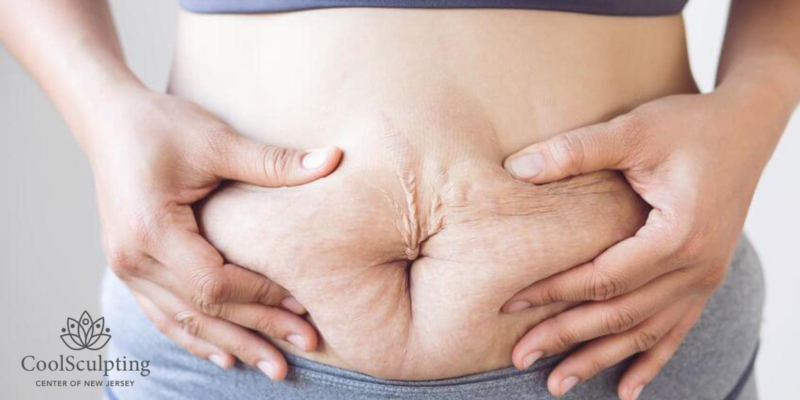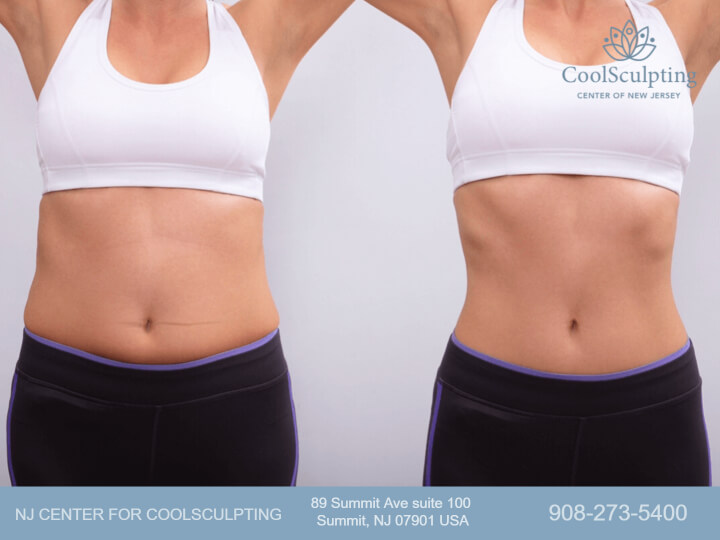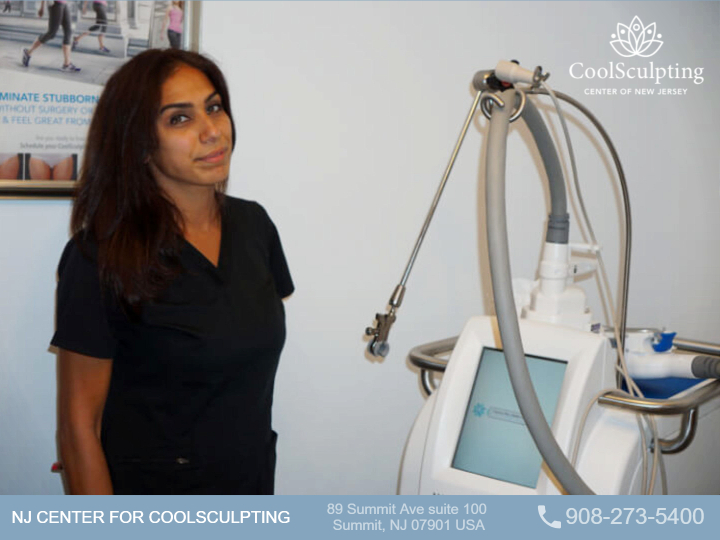Menu
(908) 628-1070

CoolSculpting is a miracle treatment that removes the fat in different parts of the body by freezing the adipose cells and allowing the body to flush them out completely. Since it is a fat removal procedure, potential patients are worried if this treatment can also lead to saggy skin if too much fat is eliminated.
So what happens to the excess skin after a CoolSculpting treatment? Most patients experience smoother and firmer skin in the treatment area because CoolSculpting also boosts the collagen production of the body. However, paradoxical adipose hyperplasia (PAH) can also happen in exceedingly rare cases. It is a treatable complication that can be solved with liposuction or abdominoplasty.
Skin is the largest organ in the body. It’s also considered the body’s protective barrier against the environment and other pollutants. Two of the most important proteins in the skin are collagen and elastin. Collagen provides the skin its strength, firmness, and structure while elastin gives it elasticity. Both of these components are important in keeping the skin stay tight.
As a person gains weight, the skin also expands to cope with the growth in the abdomen, thighs, arms, and other parts of the body. Most of the time, the skin retracts within several months if the expansion is temporary – like it does during a woman’s pregnancy.
However, for obese and overweight people who have carried extra weight for years, the skin has remained stretched for years. This results in damaged collagen and elastin fibers which lose their ability to retract.
With damaged protein fibers in their body, people who undergo major weight loss – either from surgery or lifestyle change – might experience saggy skin. Another contributing factor to skin laxity after weight loss is the reduced production of new collagen in the body; even when these proteins are produced, their composition is far inferior to the new collagen in a healthy body.
Although fat reduction and weight loss are often confused with each other, these terms refer to two different things. Fat reduction is the elimination of body fat in different areas without affecting much of the person’s weight. On the other hand, weight loss is the decrease in overall body weight, which means getting rid of fat, muscle, and water.
While significant weight loss usually results in saggy skin, fat reduction treatments produce modest physical changes to the body. This allows the skin to retract easily and return to its original shape.
One popular fat reduction and body contouring treatment is CoolSculpting. This procedure utilizes “cryolipolysis” to eliminate the bulges and stubborn fat in the body. It is a non-surgical treatment that offers minimal downtime with permanent results.
The discovery of fat-freezing treatment began when two Harvard scientists noticed a reduction in the cheek fat of children who ate enough lollipops. Since fat freezes quicker than water, they used this principle to freeze the adipose cells without affecting the overlying skin tissue, which is mostly made up of water.
Cryolipolysis is the process used by CoolSculpting to reduce body fat. A special device isolates the treatment area and exposes the adipose cells to cold temperatures. Once the fat cells freeze and crystallize, the cell membrane splits open, preventing it from storing more fat.
With adipose cells destroyed in the treated area, the body’s lymphatic system is alerted to eliminate the dead fat cells. This natural body process might take several weeks to complete.
The doctor or CoolSculpting provider will assess the shape of the fatty bulge and determine the appropriate applicator size to be used. A gel pad will be applied to the treatment area to protect the skin. The applicator will be placed on the treatment site and the bulge is suctioned, causing patients to experience a pulling sensation.
The temperature inside the device will also start dropping to freeze and kill the fat cells in the treatment area. The site may feel uncomfortable at first, but it eventually becomes numb because of the extreme cold applied by the device.
CoolSculpting treatment can take around an hour to complete. After removing the applicator from the skin, the provider will massage the treated area to break up any frozen tissues. Massaging will also help the body eliminate the fat cells quicker. To achieve the best results, a patient might need multiple CoolSculpting sessions.
CoolSculpting is a non-surgical procedure that doesn’t have downtime, so most patients typically return to work immediately after a session. The initial results may start showing within a few weeks after the procedure, but the full effects of CoolSculpting may take a couple of months.
But as with any procedure, CoolSculpting comes with a few side effects. Patients may experience soreness, redness, and skin sensitivity in the treatment area. These symptoms are mostly temporary and will subside within a few days.
One rare but serious side effect of CoolSculpting experienced by some of the treated patients is the Paradoxical Adipose Hyperplasia (PAH). This condition refers to the unexpected increase in the adipose cells present in the treated area after the procedure. To eliminate the fat caused by PAH, an additional fat reduction and skin tightening treatment might be required.
Finding a certified and experienced CoolSculpting provider will help minimize the risk of acquiring these side effects. They will also ensure a safe procedure that will produce long-lasting results.
Although both treatments help reduce stubborn fat and eliminate the bulges in different parts of the body, liposuction is a surgical procedure that involves anesthetizing, cutting, and stitching. This procedure also allows more fat to be removed from the body in a single session. However, liposuction poses more health risks and requires a longer downtime than CoolSculpting.
Some of the risks that accompany liposuction are:
Since liposuction extracts more fat in the body, skin laxity is also more prevalent in this procedure. The more fat is removed from the patient’s body, the more saggy their skin may become.

CoolSculpting is a non-surgical fat reduction treatment that reshapes the body with minimal risks and downtime. Aside from safely eliminating the stubborn fat in different parts of the body, this procedure can also leave the skin of the treated area in a better state.
Here are two ways that CoolSculpting can improve the skin:
Fat reduction treatments are more successful for patients who have skin that can retract to fit their slimmer bodies. Liposuction is discouraged for patients with poor skin elasticity because it increases the occurrence of loose skin after the treatment.
However, CoolSculpting works differently. Since it only involves less fat reduction than liposuction, the skin can retract to the body’s contours more naturally. Most patients also reported that the reduction of bulge size in the treatment area did not result in increased laxity. It also doesn’t change the tone of the skin.
CoolSculpting patients have also reported that their skin in the treatment area adopted a smoother texture after the body contouring treatment. One possible reason for this is the phenomenon called “cryodermadstringo.” This process utilizes extremely cold temperatures to trigger the body’s collagen production, resulting in tighter and smoother skin.
However, surgical procedures like abdominoplasty are still considered as the primary treatment for removing the excess skin. While the effects of CoolSculpting for the skin’s firmness and elasticity are promising, it should not be adopted as an alternative to other skin tightening treatments.
CoolSculpting is designed to freeze the fat cells and destroy them so that the body can flush them out naturally. While this happens in most cases, around 0.0051% of CoolSculpting patients reported that the treatment area expanded and hardened into an unnaturally shaped lump due to the extreme cold.
This condition is called paradoxical adipose hyperplasia – the abnormal increase in the fat or bulge structure. Instead of shrinking, the adipose cells in the treatment area increased in size and became firmer than the surrounding tissues. The unnatural bulge is usually likened to a “stick of butter” shaped like the CoolSculpting applicator.
Instead of shrinking, the bulge may gradually increase in the treatment area after a CoolSculpting treatment for patients who develop PAH. Although there is no clear explanation of why this phenomenon happens yet, there are a few theories about why the bulges gradually increase in size after the treatment.
Some of the suspected mechanisms that lead to the development of paradoxical adipose hyperplasia in CoolSculpting patients are:
The good news is that PAH is a treatable and non-life-threatening condition. However, patients may need to wait for several months before undergoing another fat removal procedure. This is to ensure that the fat has already softened enough for safe elimination.
Patients who experienced this complication after their CoolSculpting procedures opted for either of the following treatments to remove the fat and tighten the skin:
Liposuction is a fat removal treatment that requires surgery. It is typically performed on healthy patients who want to remove fat deposits on the abdomen, buttocks, thighs, and hips. It eliminates stubborn fat in the area by creating small incisions at the treatment site, loosening the adipose cells underneath the skin, and sucking out the dislodged fat.
With liposuction, patients will see a flatter stomach and better proportions after the recovery period. This procedure permanently removes the fat cells in the treatment area, but fat can still reaccumulate if the patient gains too much weight. It also comes with a few complications, such as fat embolism, internal organ puncture, and infection. These risks can be minimized by making sure that the surgeon who will perform liposuction is licensed, experienced, and board-certified.
Although liposuction is considered an effective treatment for PAH, it might not be effective for skin tightening. If the PAH has caused the skin to stretch too much, an abdominoplasty might be required after the liposuction treatment.
Abdominoplasty (also known as a tummy tuck) is another surgical procedure that can be used to treat PAH. This procedure can remove excess fat and skin in the treatment area. Although this surgery won’t be enough to provide patients with toned abs, it’s enough to flatten the extra bulge in the abdomen.
Aside from PAH patients, this treatment option is also good for people who went through pregnancy or significant weight changes. Since the skin around the stomach is extremely stretched, it may have a hard time retracting back to the body. In this case, it’s better to pull the skin tight through surgery and trim the excess skin.
The results of a tummy tuck are also permanent. The abdominal wall was also observed to be stronger and more stable after an abdominoplasty. But like most surgical procedures, tummy tuck also comes with a few risks, such as tissue necrosis, fluid accumulation, and changes in sensation.

Weight loss is a great accomplishment that reduces your chances of developing different weight-related conditions, such as heart diseases, diabetes, hypertension, and more. However, extreme changes in appearance can cause the skin to be lax.
On the other hand, fat reduction and body contouring treatments don’t result in saggy skin most of the time because the changes are more modest. Some patients even experience tighter skin after non-invasive fat reduction treatments like CoolSculpting, because the temperature triggers the body’s production of more collagen and elastin – the protein responsible for giving the skin its health and structure.
But in case you notice the skin sag a bit after either weight loss or other fat reduction treatments, you can try the following skin tightening treatments:
Natural remedies, such as collagen supplements and firming creams, can help improve the skin’s elasticity and strength to some degree. It’s also ideal for patients who experience mildly sagging skin after reshaping their figure.
Firming creams available in the market contribute to skin tightening because they contain elastin and collagen. However, they can only provide a slight boost to the skin’s health because their molecules are too large to be absorbed through the skin. It’s still better to take collagen orally.
Collagen hydrolysate (or hydrolyzed collagen) is a gel-like substance harvested from the connective tissues of some animals. It is a processed compound that has been proven to have protective properties on the skin’s collagen. This substance can be bought in powdered or capsule form from food stores.
Other nutrients that also contribute to better skin quality are:
A popular non-surgical treatment to tighten the skin is radiofrequency (RF) therapy. It utilizes energy waves to heat the dermis (deep layer of the skin). The heat triggers the production of collagen in the body, making the skin firm.
Radiofrequency treatments use waves that are around 122 – 167 degrees Fahrenheit to help the body release heat-shock proteins and develop new collagen fibers. Each procedure lasts for about an hour.
Aside from tightening the skin, radiofrequency treatment is also useful for erasing wrinkles, protecting the skin against sun damage, body contouring, face contouring, and face slimming.
Intense Pulsed Light (IPL) treatment is another non-surgical skin tightening treatment that can also minimize the appearance of age spots, freckles, birthmarks, and varicose veins. It can also be used to remove unwanted hair on different parts of the body.
This treatment works like laser treatment: a laser is focused on the skin to penetrate the dermis without affecting the epidermis. The main difference between the two is that IPL utilizes light of various wavelengths instead of just one. Like radiofrequency treatment, IPL boosts the body’s production of new collagen.
Here at NJ Center for CoolSculpting, our board-certified doctors are experienced in performing CoolSculpting to different patients. This allows us to ensure that the risk of developing complications, such as paradoxical adipose hyperplasia (PAH) is minimized.
With NJ Center for CoolSculpting, patients don’t need to worry about saggy skin after a CoolSculpting treatment. This procedure only provides modest and natural-looking changes to the body shape. For more information, consult with us now at NJ Center for CoolSculpting.
Read more: How Does Fat Leave Your Body After CoolSculpting?